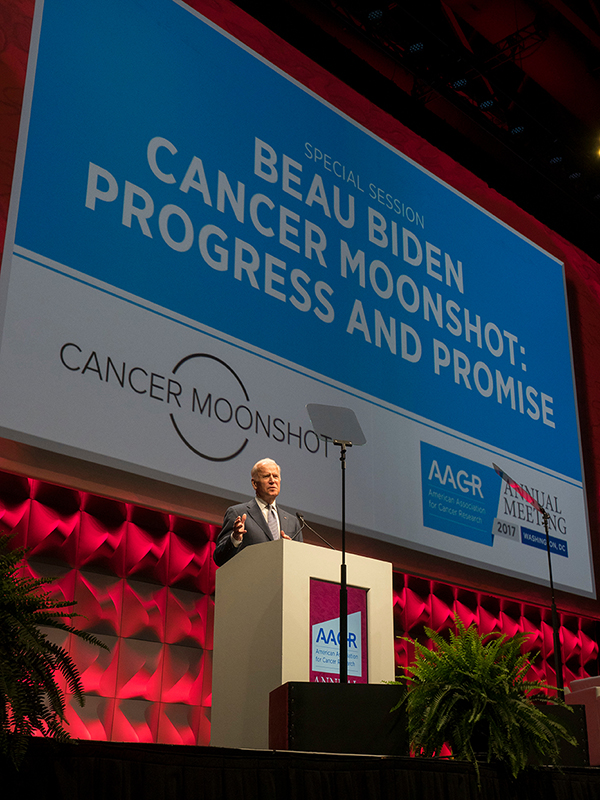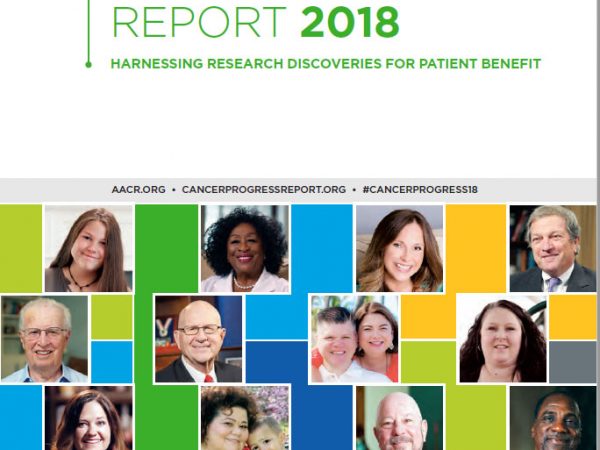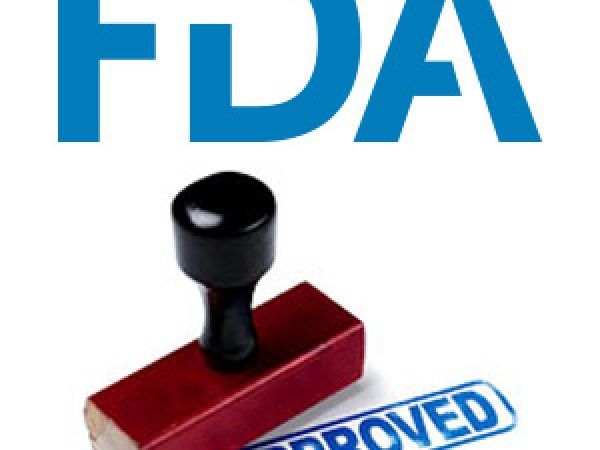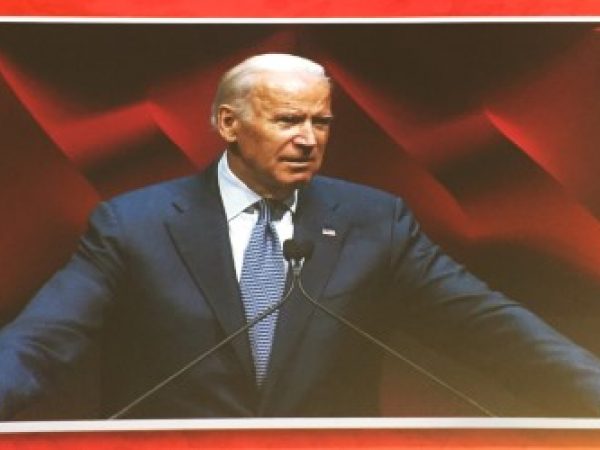What Biden’s Presidency Will Mean for Cancer Research
Editor’s note: As President Joseph R. Biden Jr. took office on Wednesday, Cancer Discovery, a journal of the American Association for Cancer Research, published an article examining how the Biden administration might approach cancer research funding and patient care. Driven by his son’s death from glioblastoma, Biden helped launch the 2016 Cancer Moonshot initiative and is now expected to renew efforts to accelerate progress against cancer. In this piece, writer Elie Dolgin interviewed prominent cancer scientists about Biden’s past efforts, and how those initiatives may regain momentum in the Biden administration.
On a campaign stop in Iowa in June 2019, Joe Biden declared, “I promise you if I’m elected president, you’re going to see the single most important thing that changes America: We’re gonna cure cancer.”
As Biden now ascends to the presidency, the cancer research community is watching closely to see what steps he takes to reach that goal.
Some hope he will continue building on the Cancer Moonshot initiative, launched when Biden served as vice president. Others are pushing for cancer research to be included in the next COVID-19 relief package. Many acknowledge that the pandemic remains the top health care priority for now, but expect cancer-related issues to rise in importance over the next four years. All agree that cancer research will be part of the Biden administration’s legacy in one form or another.
“These are things that I know that the president-elect cares deeply about,” says Ronald A. DePinho, MD, of The University of Texas MD Anderson Cancer Center in Houston, whose own Moon Shots Program, launched in 2012, helped inspire Biden’s effort four years later. “He is science-driven. He is results-oriented.… I can’t imagine him not putting a lot more fuel in the rocket for cancer.”
Biden became the country’s cancer advocate-in-chief following the 2015 death of his son Beau to glioblastoma. He dedicated the last year of President Barack Obama’s term to fighting cancer through the White House’s Cancer Moonshot initiative. Its goal: accelerate research, make more therapies available to patients, and facilitate disease prevention and early detection. Biden often spoke about doubling the rate of progress toward a cancer cure—achieving in five years what would otherwise take 10.

A Blue Ribbon Panel of experts identified 10 research priorities. These ranged from the need to create various research networks—some focused on emerging treatment modalities such as immunotherapy, others geared to improving outreach and patient engagement—to funding technology development and the generation of tumor atlases. Overcoming treatment resistance and the need for evidence-based symptom management also made the list, as did a push to interrogate fusion-driven pediatric cancers, among other recommendations. Undergirding it all: a focus on greater data sharing and collaboration.
“A lot of what has to be done to really accelerate cancer progress is under the hood. It’s the non-sexy stuff, but [Biden] gets that,” says David Agus, MD, of the University of Southern California in Los Angeles. “He realizes that he will help build the infrastructure so we can scale at a pace like we never have before.”
The 21st Century Cures Act, signed into law in December 2016, then made that progress possible, with $1.8 billion in supplemental funding earmarked for the National Cancer Institute (NCI) over a seven-year period.
Achieving liftoff
Four years in, NCI Director Norman Sharpless, MD, says that the Moonshot funding has yielded “a tremendous research portfolio” that has amassed 240 new research projects across more than 70 cancer science programs. Results feed into a cloud-based data science infrastructure accessed by more than 70,000 people per month.
“The Moonshot happened at a very opportune time because it provided the resources to get a lot of very translational work done,” Sharpless explains. “Because of the productivity of the basic science engine over the last decades, now what was really needed was something to carry some of these ideas from the preclinical space into that next realm of clinical research.”
The initiative was about much more than additional NCI funding, though. For Biden, the Moonshot was a call to action, an all-hands-on-deck effort across government and the private sector to advance research, improve clinical care, and help patients through their cancer journey.
Numerous federal agencies played a role. The Department of Health and Human Services, for example, overhauled its public clinical trial repository and issued new rules about reporting results. The FDA created its Oncology Center of Excellence to accelerate regulatory review of cancer drugs and devices. The Patent and Trademark Office established a fast-track review process for cancer immunotherapy-related patent applications. The National Endowment for the Arts launched an art therapy program for people with cancer and survivors.
The departments of Defense, Energy, and Veterans Affairs, along with the National Aeronautics and Space Administration, all formed strategic collaborations with the NCI. And the National Institutes of Health—inspired by the mandate that all grantees of Moonshot-funded projects publish their results in an open-access format—has begun to explore ways to promote unfettered access to research findings more broadly.
“We’re using cancer as the test case, but really working to break down silos across the entirety of the biomedical research enterprise,” says Lyric Jorgenson, PhD, deputy director for the NIH Office of Science Policy.
At Biden’s urging, dozens of companies and nonprofits also made commitments to do their part. Drugmakers pledged millions of dollars to support cancer detection and survivorship programs. Ridesharing apps promised free rides to patients for medical appointments. Through vacation rental websites, homeowners offered patients who needed to travel for care a place to stay at no charge.
“Joe uses his bully pulpit methodology very effectively to get folks to work together and to get more done,” says Stanton Gerson, MD, director of the Case Comprehensive Cancer Center in Cleveland.
Taking initiative
After Biden left public office, he maintained the momentum of the Moonshot through a short-lived nonprofit called the Biden Cancer Initiative (BCI). The organization secured commitments from various stakeholders to spend nearly $600 million collectively on programs related to patient support and education, clinical trials, access to care, data standards, and other topics.
In July 2019, however, shortly after Biden announced his run for president, the BCI suspended operations, a sudden move that Catharine Young, PhD, former senior director of science policy at the nonprofit, describes as “heartbreaking.”
“Because we shut down sooner than we actually anticipated, we weren’t able to get to the maximum execution part,” says Young, who now leads the Shepherd Foundation, a nonprofit dedicated to rare cancers. But, she adds, “when we did suspend, Joe Biden said there was no question this work would continue if he did become president.”
Meanwhile, the Trump administration elected not to continue the federal Moonshot program. The NCI funding continued, as did some initiatives at other agencies, but the Cancer Moonshot Task Force—an interagency working group comprising senior leadership from across the government that had met biweekly to discuss progress and challenges—disbanded. Momentum stalled. Coordination faltered. Partnerships languished. And ever since, “there just hasn’t been enough leadership to make sure it kept going,” says AACR Past President Elizabeth Jaffee, MD, of Johns Hopkins University in Baltimore, who co-chaired the Moonshot Blue Ribbon Panel and served on the BCI’s board of directors.
With Biden entering the Oval Office—and with the Democratic Party’s pledge to build on the Moonshot’s 2016 foundation—most cancer researchers and policymakers now expect that to change.
“One can only imagine that, given Biden’s passion and his understanding of the cancer problem, this will continue to be a priority for him,” says Karen Knudsen, PhD, president of the Association of American Cancer Institutes and enterprise director of the Sidney Kimmel Cancer Center at Thomas Jefferson University in Philadelphia. “Hopefully we see something like the Moonshot come out in this next administration with some clear objectives of what can be accomplished in the short and long term.”
To that end, Agus, Jaffee, and Chi Van Dang, MD, PhD, of the Ludwig Institute for Cancer Research in New York, have some ideas about what could be next. Outlining their vision for a “Moonshot 2.0,” the three researchers propose setting new data standards and establishing data repositories for sharing real-world patient records in a privacy-protected way. They also call for a focus on machine learning to better understand tumor biology and clinical outcomes; enhancing molecular imaging and noninvasive liquid biopsy techniques to identify malignancies at an early, more treatable stage; and technologic improvements in targeted drug delivery and cellular engineered products.
“All the things that people thought about for the first Moonshot clearly need to be bolstered and continued,” says Dang, who served on the Moonshot’s Blue Ribbon Panel and, together with Agus and Jaffee, is now leading a commission convened by The Lancet Oncology to draw up a new scientific roadmap for achieving cancer control, as they did four years ago.
Pandemic relief
Initially, the coronavirus pandemic will remain Biden’s number-one health priority, but “I don’t think that’s going to come at the peril of oncology,” says Jeff Allen, PhD, executive director of Friends of Cancer Research in Washington. Biden “may not talk about [cancer] every day. It may not be as readily apparent because of some of the other things on health care that he is going to have to deal with. But it’s not going to be absent,” Allen says—especially given that this year marks the 50th anniversary of the National Cancer Act, signed into law in December 1971.
One sign of Biden’s commitment to the research enterprise came on January 15 when he nominated Eric Lander, PhD, of the Broad Institute in Cambridge, Massachusetts, to serve as science adviser and director of the Office of Science and Technology Policy, a position Biden has elevated to Cabinet-level status for the first time. A pioneer in genomics for cancer and other diseases, Lander has cofounded several oncology startups and served on the BCI board.
Many of Biden’s closest confidantes are also dedicated to the cancer cause. His wife, Jill, is a longtime advocate for breast cancer research and early detection; as First Lady, she is expected to continue that work. Vice President Kamala Harris is the daughter of an accomplished cancer researcher, Shyamala Gopalan, who died of colon cancer in 2009.
Which then raises the question: Among those close to the president, “who’s going to be on point for cancer? Will there be a new cancer czar?” says David Arons, JD, CEO of the National Brain Tumor Society and a member of the Blue Ribbon Panel.
One thing seems certain, though. “There is an advocate [for cancer] in the White House like never before,” says Allen. So, for cancer researchers, there’s little doubt that another major initiative is in the offing. “It’s not whether Cancer Moonshot 2.0 is going to happen or not—it will happen,” Dang says. “It’s just a question of when.”



